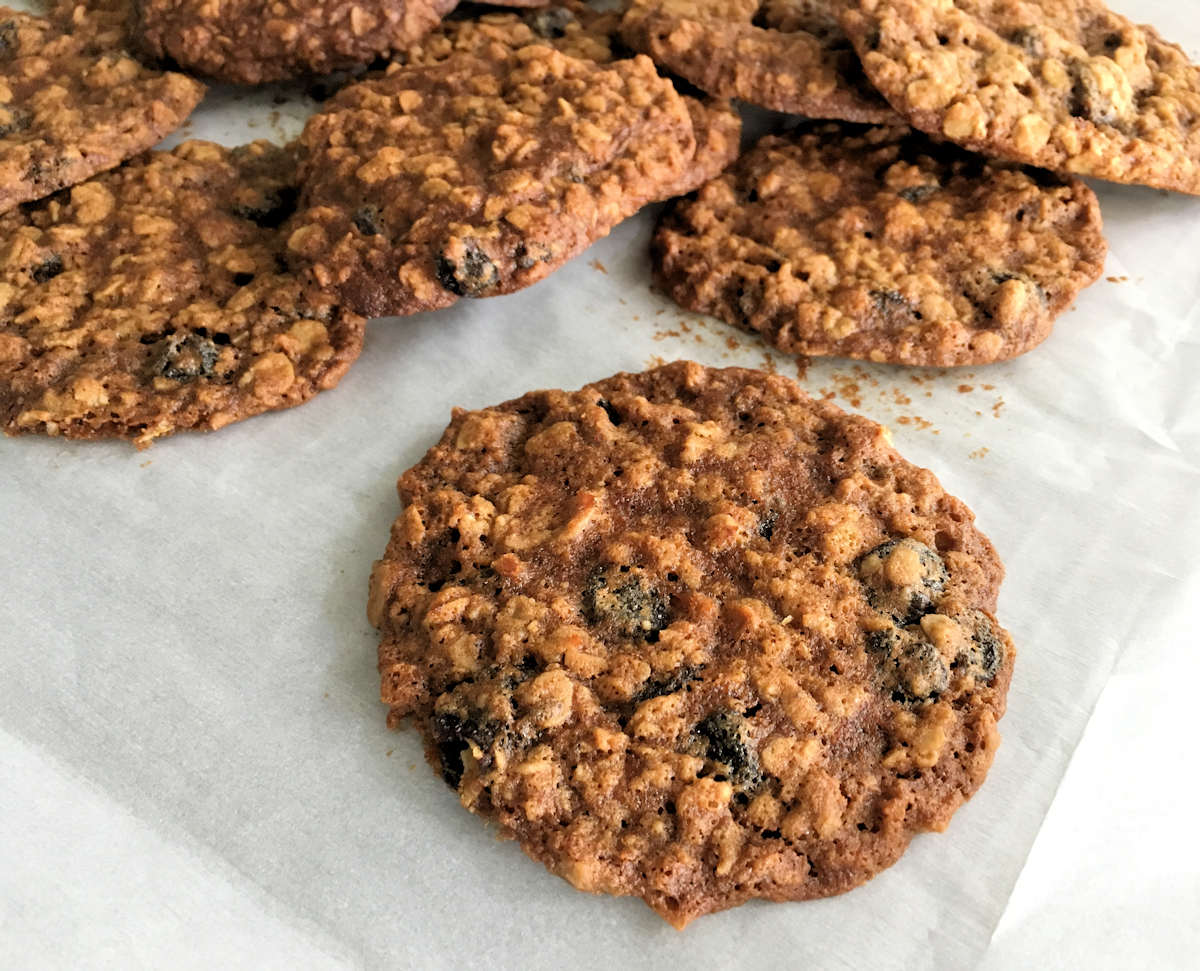Oatmeal raisin cookies, a dessert with redeeming features: the fibre from oats and the goodness of ‘one of five a day’ from raisins.

Oats are one of the most popular and versatile grains, but did you know that there are different types of oats with different characteristics and uses?
Whole oat groats
These are the whole oat kernels that have been cleaned of their inedible hulls. They are the least processed form of oats and retain the most nutrients and texture.
They have a chewy and nutty flavour and can be cooked as a hearty porridge or used in salads, soups, stews, and pilafs. They take the longest to cook, about 50-60 minutes, and require a lot of water.
Pinhead / Steel cut oats
These are whole oat groats that have been cut into two or three pieces with a sharp metal blade. They have a coarser texture than rolled oats and a more pronounced oat flavour. They take about 20-30 minutes to cook and can also be used in baking, granola, and muesli.
Oatmeal
These are whole oat groats that have been stone-ground into smaller bits of varying sizes, from coarse to fine. In the UK they are used mainly for baking or for coating for fish or meat, but in US they are called ‘Scottish oats’ and made into creamy porridge.
Rolled / Old-Fashioned / Jumbo oats
These are whole oat groats that have been steamed and then rolled into flakes. They have a softer texture than steel cut oats and a milder flavour. They are the most common type used in porridge, granola, muesli as well as baking, especially for oatmeal cookies, flapjacks and breads.
Quick / Porridge oats
These are rolled oats that have been cut into smaller pieces and steamed for longer. They have a finer texture than rolled oats and cook faster, about 1-2 minutes, so convenient for busy mornings. They can also be used in baking, but they tend to produce denser and less chewy results than rolled oats.
Instant oats
These are quick oats that have been pre-cooked and dried, usually with added flavours and sweeteners. They only need hot water or milk to rehydrate them, making them the most processed type of oats with the least nutritional value. They are not recommended for baking or other uses besides instant porridge.
Oat bran
This is the outer layer of the oat kernel that contains most of the fibre and some of the protein. It is separated from the rest of the oat during milling and sold as a by-product. It is not considered a whole grain because it does not contain the germ or the endosperm of the oat. It can be added to cereal or other dishes for extra fibre.
Oat flour
This is a whole grain flour that is made by grinding whole oat groats or rolled oats into a fine powder. It has a light texture and a sweet oat flavour. It is commonly used a gluten-free alternative to wheat flour in baking in a mix with other flours or binding agents.
Oatly, madly deeply
I do have a minor obsession with oats. Porridge and I go back to before anyone else was interested in cooking oats first thing in the morning. I have always loved muesli and granola, admittedly sometimes cheating on oats with barley or wheat flakes.
Bread making and oats go together too: porridge bread is one of my favourites and oatmeal sourdough is on my to do list. Oats are welcome everywhere: on or in bread rolls; oats in sweet cereal bars and in savoury biscuits. Oats in oatcakes. Oats in smoothies. Oats in cakes? Yes, indeed.
Oats in cookies!
And finally, cookies. That’s the peak of my love affair with oats because oat cookies are ludicrously lovely.
I might have said before I’m not that big on chocolate so you know what? You keep all the double, triple, fiftyple chocolate chip cookies in the world and I’ll have my oatmeal and raisin ones.
How to make oatmeal cookie dough?
I like the combination of pinhead and rolled oats in this dough: the resulting texture is fantastic. The usual cookie mix of dark as well as white sugar gives them chewy inside and crispy outside.
And it’s an easy job: beating butter with both sugars and egg, then stirring a mix of flour and oats in, with raisins added at the end.
As usual, they shape and bake better if you let the dough chill for at least half an hour. As also usual, you can keep the dough in the fridge for several days and longer in the freezer. But who would?
When baking, they spread a lot so make sure you space them well apart on trays or risk one enormous cookie plank. When coming out they will still be squishy and soft, setting as they cool.
More oat baking recipes
Blue cheese and oats biscuits. These savoury cheese and oatmeal cookies are easy to make and taste nicely different than ordinary cookies.
Date porridge is naturally sweet, prepared the night before and cooked within minutes into chunky, nutritious and kick-ass breakfast.
Lemon and blueberry flapjacks, easy to make and much healthier than off-the-shelf bars, naturally flavoured with lemon juice and zest, with freeze-dried blueberries.
More cookie recipes
Blueberry cookies, chewy and delicious, with fresh blueberries or bilberries (wild European blueberries), easy and quick to make as there’s no need to chill the dough.
Mokonuts-style jewelled cookies with chopped pistachios, dried apricots, cherries and dates. So tasty you’ll want to visit the Paris bakery instantly. Or make double the amount at home.
Chewy and crispy chocolate chip cookies with white and brown sugar. These are triple choc, but you can use the chocolate chips of your choice: dark or white or milk.